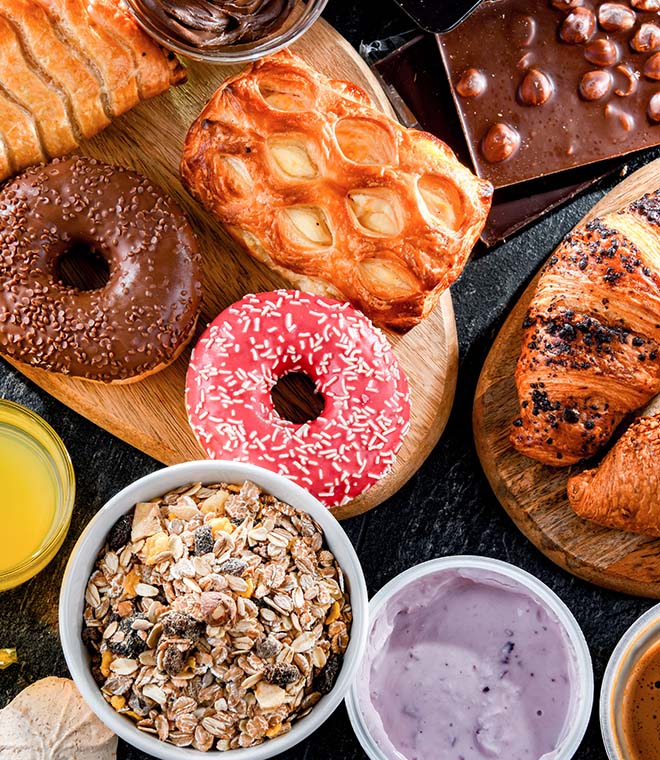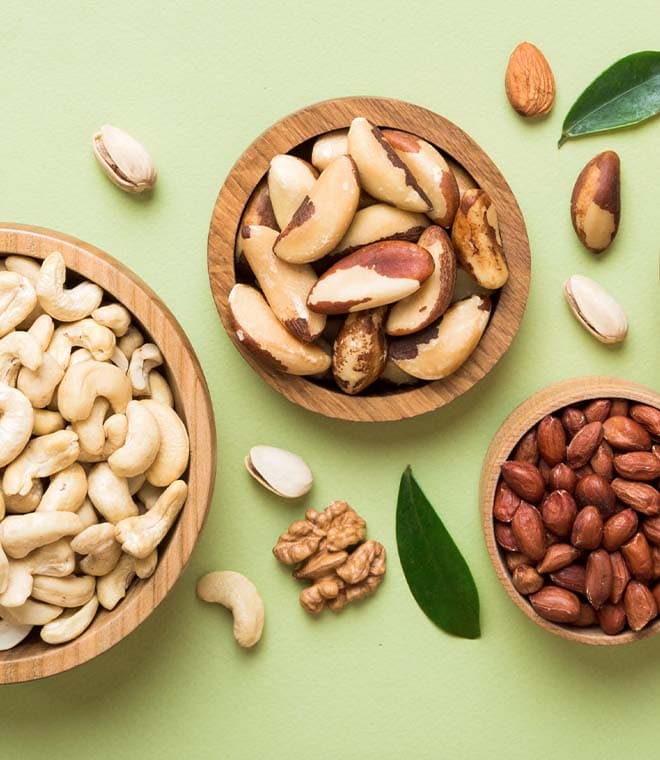Wellness
What are foods to avoid with diabetes?
By Michelle Katz, MS, RD, certified diabetes care and education specialist Apr 28, 2025 • 7 min
If you have prediabetes or diabetes, following a healthy eating plan can lead to better blood sugar control and a lower risk of complications associated with these conditions. Some foods are better choices to include in your eating plan than others.
The following are all foods you should generally avoid or limit in order to support your health and well-being:
1. Sugary foods: Foods sweetened with sugar, like cookies, cakes, candies, chocolate bars, doughnuts and even some breakfast cereals, can cause significant spikes in your blood sugar (glucose) level. If you have a sweet tooth and would like to indulge occasionally, look for alternatives made with low- and no-calorie sweeteners. Keep in mind that it’s also important to limit portion size. You can also enjoy sweet fruits with a low glycemic index like apples, oranges, pears, blueberries and strawberries. These are much healthier options.
2. Sugary drinks: Like sweets, sugary drinks can also cause your blood sugar levels to rise rapidly. Water, diet soda, and unsweetened tea and coffee are considered better choices compared to regular soda, fruit juice, energy drinks, sports drinks and coffee drinks prepared with sugar or syrups (e.g., high-fructose corn syrup).
3. Foods high in sodium: Consuming too much sodium can contribute to hypertension. People with diabetes are twice as likely to have high blood pressure or hypertension than those who don’t have the condition. The Centers for Disease Control and Prevention (CDC) report that 6 out of 10 people with diabetes have hypertension. High blood pressure increases the risk of heart disease, stroke and kidney disease. Managing your sodium intake and controlling your blood pressure is an important part of your treatment plan to maintain your overall health if you have diabetes.
4. Highly processed foods: Many people think they get the majority of their sodium from table salt added to foods during the cooking process at home or when eating meals. In reality, over 70% of dietary sodium comes from prepared or packaged foods. These foods often contain added sugars. They are also high in calories and low on nutrients. This can potentially lead to weight gain.
Do your best to limit these types of foods, which include:
- Bacon, cold cuts, hot dogs, and other smoked and cured meats
- Frozen dinners
- Canned foods such as some soups, ravioli, chili and baked beans
- Processed cheeses like nacho cheese sauce and American cheese
- Salted nuts, potato chips and other snacks
- Salad dressings and condiments
- Salted butter
Low-sodium versions of some of these foods are often available. If you are using salt to flavor your meals, consider using herbs and sodium-free seasonings instead.
Although avoiding processed foods entirely is rarely an option, reading the ingredient and nutrition facts labels carefully to find out how much sodium the item contains can help you make better informed food choices.
5. Foods high in saturated and trans fats: People with diabetes are at an increased risk for heart disease. Saturated fats increase the risk even more by contributing to blockages that may develop in the arteries. The American Heart Association recommends limiting saturated fats to less than 6% of your daily calories.
Foods high in saturated fats include:
- Butter
- Cream
- Lard
- Coconut and palm oils
- Foods fried or baked using saturated fats
- Whole and 2% milk
- Whole-milk dairy products like yogurt and cheese
Monounsaturated and polyunsaturated fats are considered healthier options. Consuming them in moderation in place of saturated fats can help lower your risk for heart disease. Foods that contain these healthier fats include:
- Fish
- Avocado
- Olives and olive oil
- Peanut oil
- Canola oil
- Cottonseed oil
- Sunflower oil
- Nuts and seeds
- Nut butters
6. Fast food: Many options at fast food restaurants have a high sodium and saturated fat content. Some popular menu items also contain added sugars. Fortunately, most chain restaurants publish their nutrition information online or on the menu screens at the restaurants, so you can compare dishes and select healthier options when your busy schedule only allows enough time to grab something from the drive-through.
7. Processed grains: Refined grains have gone through a process that strips away fiber and other nutrients. Foods made with processed grains can raise blood sugar levels quickly. Many also contain hidden sugars and sodium. Examples of foods made with refined grains include:
- White bread
- White rice
- White flour
- Corn grits
- Pastries
- Cakes
- Many types of crackers
Whole grains are more nutritious than refined grains. They contain dietary fiber that can help control blood sugar levels. They also contain essential vitamins and minerals. Try the following whole-grain alternatives to refined grains:
- Whole wheat and multigrain breads
- Brown rice
- Whole wheat pasta
- Quinoa
- Faro
- Barley
- Oatmeal
- Bulgur
- Millet
- Buckwheat
Whole grains are a source of carbohydrates, so be mindful of your portions and pair whole grains with a source of protein like lean meat or chicken for better blood sugar control.
Starting on a healthy eating plan for diabetes
If you’re striving to improve your diet to better manage your blood sugar levels and reduce your risk of complications that are often association with diabetes, your healthcare provider can assist you. They can give you advice on how many calories to consume every day and how much of certain types of nutrients like protein, fat and carbs you should strive to consume on a daily basis. Your eating plan will be developed based on factors like weight, age, sex, health history and blood sugar control goals.
Updated by Rebeca Thomas, RN, BSN, April 2025.
Sources:
- https://www.hsph.harvard.edu/nutritionsource/carbohydrates/carbohydrates-and-blood-sugar/
- https://www.heart.org/en/healthy-living/healthy-eating/eat-smart/sugar/sugar-101
- https://www.fda.gov/food/nutrition-education-resources-materials/sodium-your-diet
- https://www.verywellhealth.com/foods-high-in-sodium-7964920#:~:text=Canned%20foods%20high%20in%20sodium%20include%20products,(V8)%20*%20Sardines%2C%20anchovies%2C%20caviar%2C%20pickled%20herring.
- https://www.cdc.gov/salt/reduce-sodium-intake/index.html#:~:text=Eating%20too%20much%20sodium%20can,at%20home%2C%20and%20in%20restaurants.
- https://www.hopkinsmedicine.org/health/conditions-and-diseases/diabetes/diabetes-and-high-blood-pressure
- Petrie JR, Guzik TJ, Touyz RM. Diabetes, Hypertension, and Cardiovascular Disease: Clinical Insights and Vascular Mechanisms. Can J Cardiol. 2018 May;34(5):575-584. doi: 10.1016/j.cjca.2017.12.005. Epub 2017 Dec 11. PMID: 29459239; PMCID: PMC5953551.
- https://www.cdc.gov/high-blood-pressure/risk-factors/index.html#:~:text=a%20healthy%20range.-,Diabetes,your%20heart%20and%20blood%20vessels.
- https://www.mayoclinic.org/diseases-conditions/diabetes/in-depth/diabetes-diet/art-20044295
- https://www.heart.org/en/health-topics/cholesterol/prevention-and-treatment-of-high-cholesterol-hyperlipidemia/the-skinny-on-fats#:~:text=For%20people%20who%20need%20to,13%20grams%20of%20saturated%20fat.
- https://medlineplus.gov/diabeticdiet.html
- https://www.mayoclinic.org/healthy-lifestyle/nutrition-and-healthy-eating/in-depth/fat/art-20045550
- https://www.ucsfhealth.org/education/guidelines-for-a-low-sodium-diet
- https://www.health.harvard.edu/diseases-and-conditions/healthy-eating-for-blood-sugar-control
- https://www.urmc.rochester.edu/encyclopedia/content.aspx?contenttypeid=56&contentid=DM113
- https://diabetes.org/healthy-living/recipes-nutrition/eating-well/diabetes-superstar-foods




